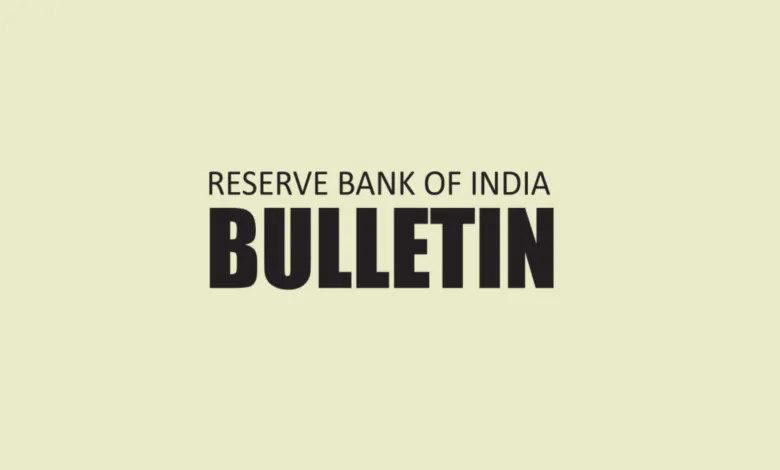
The Reserve Bank of India (RBI) has released the February 2025 edition of its monthly Bulletin. This issue includes the bi-monthly monetary policy statement (February 7, 2025), one speech, four analytical articles, and current statistics.
The four featured articles are:
- State of the Economy
- Union Budget 2025-26: An Assessment
- Quality of Public Expenditure and its Socio-economic Impact in India
- Dynamics of Agriculture Supply Chain: Insights from a Pan-India Survey during the Rabi Marketing Season
I. State of the Economy
The global economy continues to expand at a moderate pace, though growth prospects vary across countries due to shifting political and technological landscapes. Financial markets remain cautious amid slowing disinflation and potential tariff impacts. Emerging market economies (EMEs) are experiencing foreign investor outflows and currency depreciation due to a strong US dollar.
In India, high-frequency indicators suggest a pickup in economic activity during the second half of FY 2024-25, with sustained momentum expected ahead. The Union Budget 2025-26 strikes a balance between fiscal consolidation and growth, maintaining a strong focus on capital expenditure while supporting household incomes and consumption. Meanwhile, retail inflation eased to a five-month low in January, primarily due to a sharp decline in vegetable prices.
II. Union Budget 2025-26: An Assessment
Authors: Akash Raj, Harshita Yadav, Kovuri Akash Yadav, Aayushi Khandelwal, Anoop K Suresh, and Samir Ranjan Behera
This article evaluates the Union Budget 2025-26, which emphasizes fiscal discipline while promoting inclusive and long-term economic growth under the vision of Viksit Bharat. The budget prioritizes four key growth drivers: agriculture, MSMEs, investment, and exports, balancing short-term consumption support with long-term structural reforms.
Key Highlights:
- The fiscal deficit is targeted to decline to 4.4% of GDP in 2025-26 from 4.8% in 2024-25 (Revised Estimates, RE).
- Revenue expenditure is projected to grow by 6.7% in 2025-26 over 2024-25 (RE).
- Capital expenditure is allocated ₹11.2 lakh crore (3.1% of GDP), continuing the investment momentum of previous years.
- The effective capital expenditure is expected to rise to 4.3% of GDP in 2025-26 from 4.1% in 2024-25 (RE).
- Gross tax revenue is projected to increase by 10.8%, with a buoyancy of 1.07, aligning with its historical average from 2010-11 to 2018-19.
- The government remains committed to reducing its debt-to-GDP ratio to 50 ±1% by 2030-31.
III. Quality of Public Expenditure and its Socio-economic Impact in India
Authors: Rachit Solanki, Kovuri Akash Yadav, Aayushi Khandelwal, Samir Ranjan Behera, and Atri Mukherjee
This article explores the evolution of public expenditure in India since liberalization, analyzing how structural reforms, macroeconomic shifts, and policy measures have shaped expenditure quality. A Quality of Public Expenditure (QPE) Index—which considers capital outlay, developmental spending, and interest burden—has been developed using a dynamic factor model (DFM) to examine the link between public spending and socio-economic outcomes.
Key Highlights:
- India’s public expenditure trajectory since 1991 can be categorized into six distinct phases, shaped by fiscal policy reforms and macroeconomic shocks.
- Higher QPE scores correlate with stronger economic performance and improved social outcomes.
- The Centre’s expenditure quality has a stronger correlation with GDP growth, whereas States’ expenditure quality has a more significant impact on the Human Development Index (HDI).
- State-level data shows that higher QPE scores are associated with improved health and education indicators, reinforcing the role of subnational developmental and capital spending in enhancing human development.
IV. Dynamics of Agriculture Supply Chain: Insights from a Pan-India Survey during the Rabi Marketing Season
Authors: Rajib Das, Rishabh Kumar, Monika Sethi, Love Kumar Shandilya, and Alice Sebastian
This article examines agricultural supply chains through a pan-India survey conducted among farmers, traders, and retailers. Covering 12 rabi crops—including wheat, rice, maize, pulses, oilseeds, and major fruits and vegetables—the survey analyzed both production centers (key farming regions) and consumption centers (major cities) from May to July 2024. Similar surveys were previously conducted in 2018 and 2022 for major kharif crops.
Key Highlights:
- Farmers’ share in consumer prices ranges from 40% to 67%, with wheat farmers earning the highest share.
- Farmers receive a lower share for perishables (fruits and vegetables) compared to non-perishables.
- Trader and retailer markups have generally moderated over time, though retail margins remain higher, particularly for perishables.
- The combined share of traders and retailers in consumer prices exceeds 50% for all surveyed fruits and vegetables except tomatoes.
- Electronic payments usage has risen across the supply chain, though cash remains the dominant mode of transaction at mandis.
- Weather forecasts and irrigation availability are the most crucial factors influencing farmers’ rabi sowing decisions.
- Unseasonal rainfall is cited as the leading cause of crop damage, followed by pest attacks and heatwaves.
- Higher transaction costs (transportation, labor, rent) reduce retailer markups, while post-harvest losses in perishables increase consumer prices.
